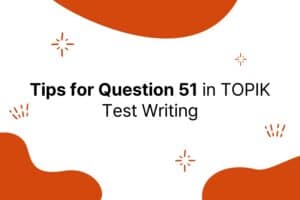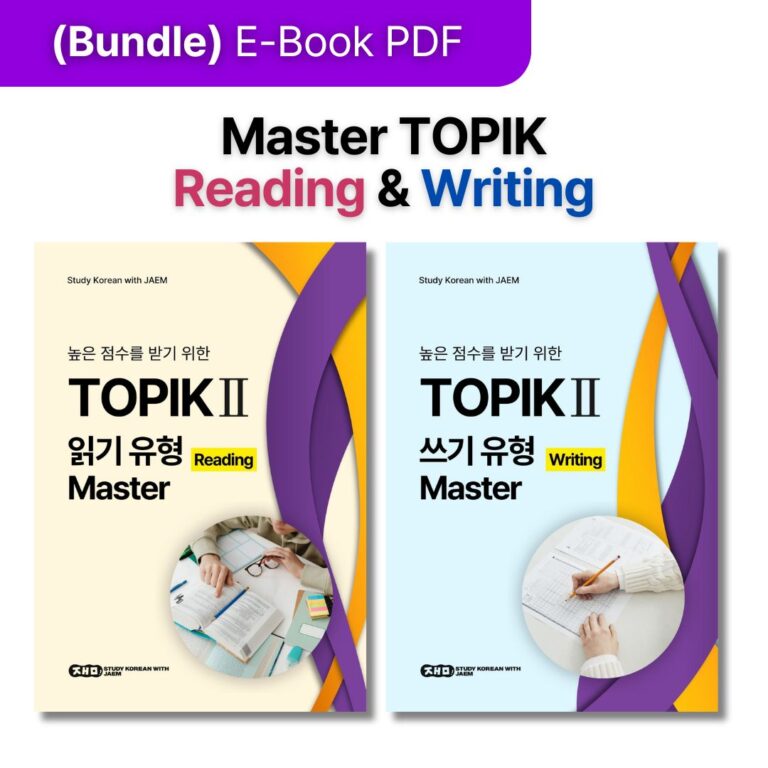Introduction: Korean Grammar ‘-아/어서’
Learning Korean grammar can be challenging, but breaking it down into manageable lessons can make it easier. Today, we will explore the grammar pattern ‘-아/어서,’ which is used to express reasons, causes, or sequential actions in Korean. This lesson will help you understand and use this form effectively.
Learn Korean with JAEM Korean App: Improve your Korean with our app through free lessons and courses. And also, Join our 4-week challenge program to progress from upper-beginner to master level with Native Korean Coaches.
AI Writing Practice Program: Enhance your writing skills with JAEM TOPIK, our AI-powered practice program. Get personalized feedback and TOPIK tips to elevate your Korean writing.
Our Book: Don’t miss out on our comprehensive book that covers essential Korean language skills and strategies.

Jump to:
Grammar Explanation
The grammar pattern ‘-아/어서’ is used to connect two clauses, indicating reasons, causes, or sequential actions. It can be translated to “because,” “so,” or “and then” in English, depending on the context.
Formation:
- If the stem has a bright vowel (ㅏ or ㅗ), add ‘-아서.’
- If the stem has a dark vowel (any other vowel), add ‘-어서.’
- If the verb stem ends in 하다, it changes to 해서.
| Verb | Stem | Form | Example Sentence |
|---|---|---|---|
| 가다 (to go) | 가 | 가서 | 학교에 가서 공부했어요 (I went to school and studied) |
| 먹다 (to eat) | 먹 | 먹어서 | 밥을 먹어서 힘이 났어요 (I ate and gained strength) |
| 하다 (to do) | 하 | 해서 | 숙제를 해서 기뻤어요 (I did my homework and was happy) |
Examples
Verb Examples:
- 보다 (to see)
- 봐서 = See and then
- 영화를 봐서 즐거웠어요 = I watched a movie and enjoyed it.
- 살다 (to live)
- 살아서 = Live and then
- 서울에서 살아서 행복해요 = I live in Seoul and am happy.
- 읽다 (to read)
- 읽어서 = Read and then
- 책을 읽어서 기뻤어요 = I read a book and was glad.
- 마시다 (to drink)
- 마셔서 = Drink and then
- 물을 마셔서 시원했어요 = I drank water and felt refreshed.
Adjective Examples:
- 크다 (big)
- 커서 = Is big and then
- 그 집은 커서 좋아요 = That house is big, so it’s good.
- 작다 (small)
- 작아서 = Is small and then
- 고양이가 작아서 귀여워요 = The cat is small, so it’s cute.
- 좋다 (good)
- 좋아서 = Is good and then
- 날씨가 좋아서 산책했어요 = The weather was good, so I went for a walk.
- 나쁘다 (bad)
- 나빠서 = Is bad and then
- 기분이 나빠서 울었어요 = I felt bad, so I cried.
Usage in Context
When using ‘-아/어서’ in different contexts, it emphasizes reasons, causes, or sequential actions.
Expressing Reasons or Causes:
- 늦어서 죄송합니다 = I’m sorry because I’m late.
- 배가 아파서 병원에 갔어요 = I went to the hospital because my stomach hurt.
- 돈이 없어서 여행을 못 갔어요 = I couldn’t go on the trip because I had no money.
Expressing Sequential Actions:
- 아침을 먹어서 학교에 갔어요 = I ate breakfast and then went to school.
- 책을 읽어서 잠이 들었어요 = I read a book and then fell asleep.
- 운동을 해서 피곤해요 = I exercised and then felt tired.
Cultural Insight: In Korean culture, providing reasons or explaining causes for actions is common. Using ‘-아/어서’ helps convey clear relationships between actions and their results or reasons.
Common Mistakes
Common Mistakes:
- Incorrect: 학교에 가서 공부를 해서요 (Redundant use of ‘-서’)
- Correct: 학교에 가서 공부했어요 = I went to school and studied.
Mistake Explanation: Ensure that ‘-아/어서’ is used correctly to connect clauses without redundancy.
Related Grammar Points
Explore these related grammar points to deepen your understanding:
- -고: To express sequential actions or equal importance.
- -니까: To express reasons or causes with emphasis on the reason.
- -기 때문에: To express reasons or causes formally.
- -고 나서: To express completing one action before another.
Practice Exercises
Practice Makes Perfect!
- Exercise 1: Conjugate the following verbs using ‘-아/어서.’
- 가다 (to go)
- 먹다 (to eat)
- 하다 (to do)
- 보다 (to see)
Answer Key:
- 가서
- 먹어서
- 해서
- 봐서
- Exercise 2: Create sentences using ‘-아/어서’ for the following situations:
- I went to school and studied.
- She ate and gained strength.
- They read a book and were glad.
- We drank coffee and felt refreshed.
Answer Key:
- 학교에 가서 공부했어요.
- 그녀는 먹어서 힘이 났어요.
- 그들은 책을 읽어서 기뻤어요.
- 우리는 커피를 마셔서 시원했어요.
Summary and Conclusion
Today, we covered the grammar point ‘-아/어서’ and how to use it to express reasons, causes, or sequential actions in Korean. This pattern is essential for conveying logical relationships between actions and their results. Continue practicing with our workbook and check out related lessons for more in-depth learning.
If you have any questions or suggestions, feel free to comment below. Happy learning!
Learn Real Korean with JAEM!
Learn Korean with JAEM Korean App: Discover the best way to learn real Korean with our comprehensive app. Enjoy a wide variety of free lessons and courses designed to help you master the language. Also, our unique 4-week challenge program guides you from an upper-beginner level to a master course, all under the guidance of Native Korean Coaches. Whether you’re just starting out or looking to refine your skills, this program offers an effective path to fluency.
AI Korean Writing Practice Program: Take your Korean writing to the next level with JAEM TOPIK, our innovative AI writing practice program. This service provides personalized feedback and practical tips tailored to your learning needs. With a focus on improving your Korean writing, JAEM TOPIK also offers specific strategies for excelling in the TOPIK exam. Benefit from expert insights and targeted advice to enhance your proficiency and confidence in writing.
Our Book: Additionally, explore our comprehensive book that covers essential Korean language skills and strategies. This valuable resource complements our app and AI program, providing a holistic approach to mastering Korean.
















Responses